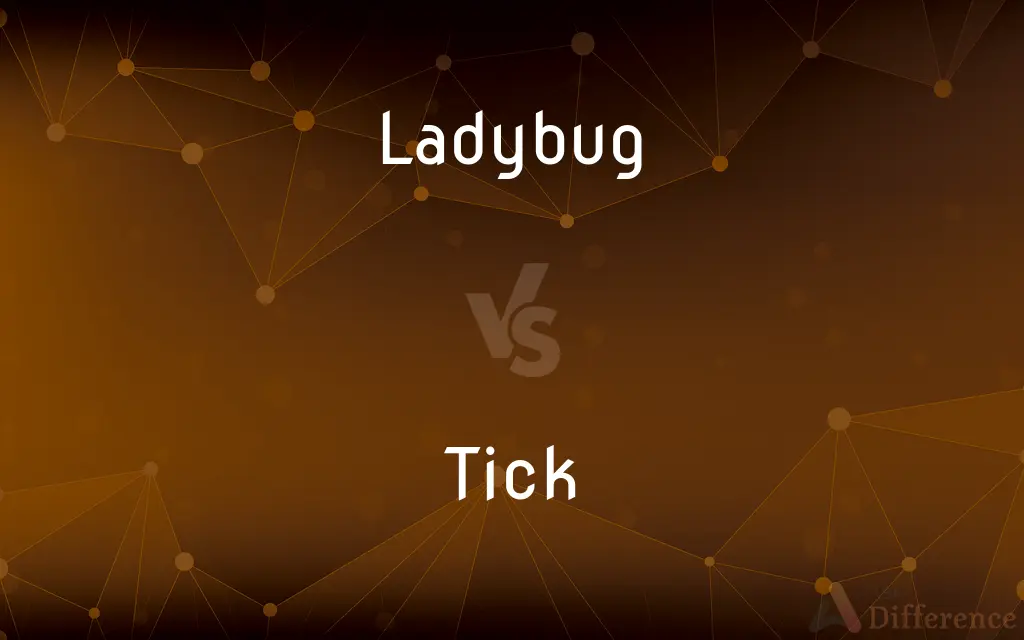Ladybug vs. Tick — What's the Difference?
Edited by Tayyaba Rehman — By Fiza Rafique — Updated on April 21, 2024
Ladybugs are beneficial, colorful beetles known for their role in controlling pests like aphids, while ticks are parasitic arachnids that feed on blood and can transmit diseases.

Difference Between Ladybug and Tick
Table of Contents
ADVERTISEMENT
Key Differences
Ladybugs are part of the Coccinellidae family, celebrated for their rounded, often brightly colored bodies and spots. Whereas, ticks belong to the subclass Acari and are known for their flat, oval bodies that expand as they feed on blood.
Ladybugs are welcomed in gardens as natural pest controllers, preying primarily on aphids and other harmful insects. On the other hand, ticks are generally unwelcome due to their parasitic nature, feeding on the blood of mammals, birds, and sometimes reptiles and amphibians.
Reproductively, ladybugs lay eggs in clusters or rows near food sources, ensuring their larvae have immediate access to food upon hatching. Meanwhile, ticks lay thousands of eggs at once, which do not require proximity to a food source as the larvae seek out hosts independently.
In terms of habitat, ladybugs can be found in various environments, from gardens and forests to grasslands, adapting to the presence of their prey. Contrastingly, ticks prefer humid environments and are commonly found in woods, shrublands, and areas with long grass, where they can easily attach to passing hosts.
Ladybugs undergo a complete metamorphosis, evolving from egg to larva, then pupa, and finally to adult form, experiencing drastic changes at each stage. Conversely, ticks also undergo several developmental stages but do not metamorphose; their changes are less dramatic, primarily involving size increases.
ADVERTISEMENT
Comparison Chart
Classification
Insect, Beetle (Coccinellidae)
Arachnid, Tick (Ixodida)
Diet
Aphids and other small insects
Blood of various animals
Reproductive Strategy
Eggs laid near food sources
Large number of eggs laid in the environment
Habitat
Gardens, forests, grasslands
Woods, shrublands, grassy areas
Development
Complete metamorphosis (egg, larva, pupa, adult)
Several stages, primarily size growth
Compare with Definitions
Ladybug
Often red or orange with black spots.
The child was delighted to find a red ladybug with seven black spots.
Tick
Parasitic arachnids that feed on the blood of hosts.
The hiker found a tick attached to his leg after walking through tall grass.
Ladybug
Undergoes complete metamorphosis.
The ladybug larvae are as effective at eating pests as the adults.
Tick
Known for transmitting diseases like Lyme disease.
Ticks are vectors for Lyme disease, which can cause severe long-term symptoms.
Ladybug
Symbolic of good luck in various cultures.
In many cultures, finding a ladybug is considered a sign of good luck.
Tick
Can survive in various climates but prefers humid environments.
Ticks thrive in humid, wooded areas where they wait for potential hosts.
Ladybug
Small, dome-shaped beetle known for its colorful body and beneficial insect-eating habits.
The gardeners appreciated the ladybugs for keeping the aphid population under control.
Tick
Females can engorge significantly after feeding.
The female tick swelled to several times its size after feeding on the dog.
Ladybug
Known for their role in biological pest control.
Farmers often introduce ladybugs into their fields as a natural pest control method.
Tick
Lacks antennae and has a specialized mouth for piercing skin.
The tick uses its sharp mouthparts to pierce the skin and attach firmly to its host.
Ladybug
Any of numerous small, rounded, usually colorful beetles of the family Coccinellidae, often reddish with black spots and feeding primarily on other insects, including pests such as scale insects and aphids. Also called lady beetle, ladybird.
Tick
Ticks (suborder Ixodida) are parasitic arachnids that are part of the superorder Parasitiformes. Along with mites, they constitute the subclass Acari.
Ladybug
(North America) ladybird.
Tick
A light, sharp, clicking sound made repeatedly by a machine, such as a clock.
Ladybug
Same as Ladybird.
Tick
Chiefly British A moment.
Ladybug
Small round bright-colored and spotted beetle that usually feeds on aphids and other insect pests
Tick
A light mark used to check off or call attention to an item.
Tick
(Informal)A unit on a scale; a degree
When interest rates move up a tick.
Tick
Any of various usually wingless insects that resemble a tick, such as a sheep ked.
Tick
A cloth case for a mattress or pillow.
Tick
A light mattress without inner springs.
Tick
Ticking.
Tick
Credit or an amount of credit.
Tick
To emit recurring clicking sounds
As the clock ticked.
Tick
To function characteristically or well
Machines ticking away.
Curious about what makes people tick.
Tick
To count or record with the sound of ticks
A clock ticking the hours.
A taxi meter ticking the fare.
Tick
To mark or check off (a listed item) with a tick
Ticked off each name on the list.
Tick
A relatively quiet but sharp sound generally made repeatedly by moving machinery.
The steady tick of the clock provided a comforting background for the conversation.
Tick
A mark on any scale of measurement; a unit of measurement.
At midday, the long bond is up a tick.
Tick
(computing) A jiffy (unit of time defined by basic timer frequency).
Tick
(colloquial) A short period of time, particularly a second.
I'll be back in a tick.
Tick
(video games) A periodic increment of damage or healing caused by an ongoing status effect.
Tick
A mark (✓) made to indicate agreement, correctness or acknowledgement.
Indicate that you are willing to receive marketing material by putting a tick in the box
Tick
(birdwatching) A bird seen (or heard) by a birdwatcher, for the first time that day, year, trip, etc., and thus added to a list of observed birds.
Tick
(uncountable) Ticking.
Tick
A sheet that wraps around a mattress; the cover of a mattress, containing the filling.
Tick
Credit, trust.
Tick
A goat.
Tickhill, Tickham, Ticknock, Tickenhall Drive, Tickenhill Manor, Tickenhurst
Tick
To make a clicking noise similar to the movement of the hands in an analog clock.
Tick
To make a tick or checkmark.
Tick
To work or operate, especially mechanically.
He took the computer apart to see how it ticked.
I wonder what makes her tick.
Tick
To strike gently; to pat.
Tick
To add (a bird) to a list of birds that have been seen (or heard).
Tick
(intransitive) To go on trust, or credit.
Tick
(transitive) To give tick; to trust.
Tick
Credit; trust; as, to buy on, or upon, tick.
Tick
The cover, or case, of a bed, mattress, etc., which contains the straw, feathers, hair, or other filling.
Tick
A quick, audible beat, as of a clock.
Tick
Any small mark intended to direct attention to something, or to serve as a check.
Tick
The whinchat; - so called from its note.
Tick
To go on trust, or credit.
Tick
To give tick; to trust.
Tick
To make a small or repeating noise by beating or otherwise, as a watch does; to beat.
Tick
To strike gently; to pat.
Stand not ticking and toying at the branches.
Tick
To check off by means of a tick or any small mark; to score.
When I had got all my responsibilities down upon my list, I compared each with the bill and ticked it off.
Tick
A metallic tapping sound;
He counted the ticks of the clock
Tick
A mark indicating that something has been noted or completed etc.;
As he called the role he put a check mark by each student's name
Tick
A light mattress
Tick
Make a clicking or ticking sound;
The clock ticked away
Tick
Make a sound like a clock or a timer;
The clocks were ticking
The grandfather clock beat midnight
Tick
Sew;
Tick a mattress
Tick
Put a check mark on or next to;
Please check each name on the list
Tick off the items
Common Curiosities
What diseases can ticks transmit to humans?
Ticks can transmit several diseases, including Lyme disease, Rocky Mountain spotted fever, and tularemia.
Can ladybugs harm humans?
Ladybugs are generally harmless to humans and do not bite or sting.
What are ladybugs good for?
Ladybugs are beneficial for controlling pest populations, such as aphids, in gardens.
How do ticks find their hosts?
Ticks detect hosts through heat, vibrations, and carbon dioxide, often waiting in tall grass or shrubs.
How long can ticks live?
Some ticks can live up to 3 years throughout their various life stages.
How do I remove a tick?
To remove a tick, use fine-tipped tweezers to grasp the tick as close to the skin's surface as possible and pull upward with steady, even pressure.
Are ladybugs considered pests?
While generally beneficial, some ladybug species can become pests, especially when they invade homes in large numbers.
Are all ladybugs red?
No, while many are red or orange, ladybugs can also be yellow, black, or even pink, with varying numbers of spots.
What is the lifecycle of a ladybug?
Ladybugs go through four stages: egg, larva, pupa, and adult.
Can ticks swim?
Ticks cannot swim but can survive underwater for several days in some cases.
What should I do if a tick bites me?
Remove the tick promptly and clean the bite area; monitor for symptoms and consult a doctor if signs of illness appear.
What habitat is most dangerous for tick encounters?
Wooded, grassy, and humid environments are most conducive to tick encounters.
Do ladybugs bite?
Ladybugs can bite but their bites are not harmful and do not cause health issues.
Do ladybugs hibernate?
Yes, ladybugs hibernate during the winter, often gathering in large groups for warmth.
What attracts ladybugs?
Ladybugs are attracted to areas with plentiful food sources, such as aphid-infested plants.
Share Your Discovery

Previous Comparison
Epidural vs. Intrathecal
Next Comparison
Slappy vs. SnappyAuthor Spotlight
Written by
Fiza RafiqueFiza Rafique is a skilled content writer at AskDifference.com, where she meticulously refines and enhances written pieces. Drawing from her vast editorial expertise, Fiza ensures clarity, accuracy, and precision in every article. Passionate about language, she continually seeks to elevate the quality of content for readers worldwide.
Edited by
Tayyaba RehmanTayyaba Rehman is a distinguished writer, currently serving as a primary contributor to askdifference.com. As a researcher in semantics and etymology, Tayyaba's passion for the complexity of languages and their distinctions has found a perfect home on the platform. Tayyaba delves into the intricacies of language, distinguishing between commonly confused words and phrases, thereby providing clarity for readers worldwide.
















































